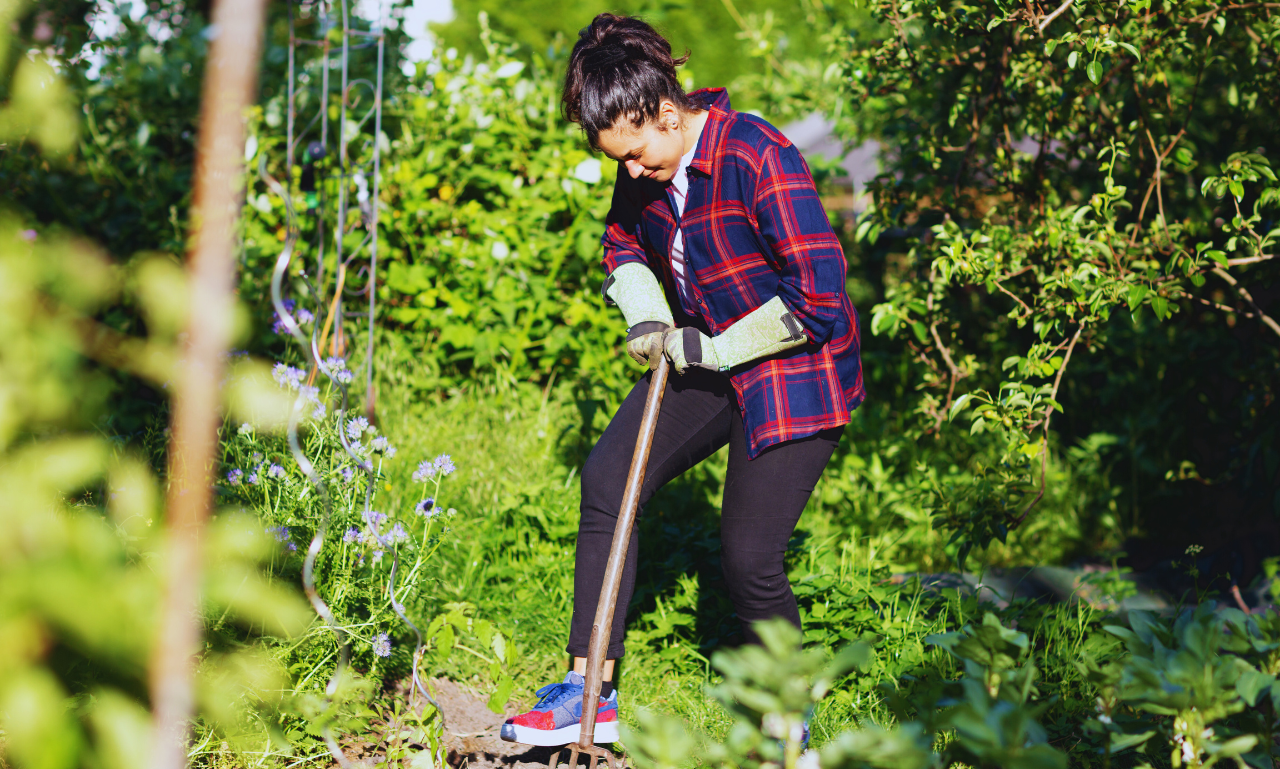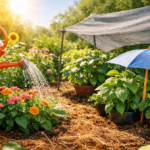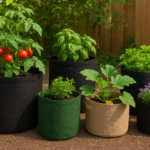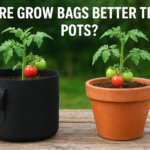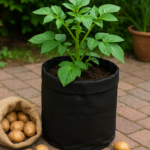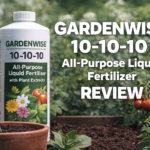Early summer is a pivotal time for gardeners, marking the transition from the fresh growth of spring to the vibrant bloom of the warmer months. During this period, typically spanning late May to early June in most regions, the weather conditions are ideal for plants to establish strong roots and lush foliage before the intense heat of mid-summer arrives. Early summer is a golden window for gardeners to tackle essential tasks that set the foundation for a flourishing garden season.
Early summer is about proactive care, from preparing the soil to planting warm-season crops and managing pest control. Your task can make a visible difference, promoting healthier plants, vibrant blooms, and a bountiful harvest. Whether cultivating vegetables, flowering plants, or maintaining a lush lawn, understanding the timing and tasks associated with early summer gardening will help you nurture your garden’s full potential and enjoy a rewarding growing season ahead.
Defining Early Summer: When Does It Start?

In gardening terms, early summer generally marks the period when temperatures rise steadily but haven’t yet reached the peak heat of midsummer. While the exact timing varies by region, early summer typically begins around late May to early June in temperate zones. It may be delayed in colder areas until mid-June, while in warmer, southern climates, it might start as early as late April or early May.
This period is ideal for gardeners because it combines ample sunlight with moderate temperatures, creating perfect growing conditions for many plants. During early summer, the soil has warmed significantly from spring’s chill, encouraging faster root development and more vigorous plant growth. Plants are ready to move beyond the gentle sprouting phase and enjoy the season’s abundant light and nutrients.
Understanding the timing of early summer in your specific region is essential. Consulting a local gardening calendar or USDA hardiness zone map can provide clarity, helping you identify when to start early summer tasks like planting, pruning, and pest management. By knowing when early summer begins for your area, you can ensure your garden has a head start on the season and thrives through the summer months and beyond.
Why Early Summer is Crucial for Gardening
Early summer is vital in the gardening season, offering the ideal conditions for plant growth and health. Here are some key reasons why this time is so crucial:
- Optimal Soil Temperature: Early summer warmth heats the soil, creating an ideal environment for warm-season crops like tomatoes, peppers, and cucumbers. This warm soil promotes faster root growth and encourages plants to establish themselves.
- Extended Daylight: With longer days, plants receive increased sunlight, which fuels photosynthesis and accelerates growth. This extra light helps plants develop more robust foliage, stronger roots, and vibrant blooms.
- Efficient Pest Management: Early summer is an excellent time to tackle common garden pests before they become a significant problem. By addressing pest control early, you can prevent infestations and keep plants healthier throughout the season.
- Favorable Conditions for Fertilization: As plants enter their growth phase, early summer is perfect for adding nutrients to the soil. Fertilizing gives plants the energy to grow stronger and prepare for fruiting or flowering.
- Timely Pruning and Maintenance: Early summer pruning helps shape plants and encourages new growth. Removing dead or weak branches redirects energy toward producing healthier foliage, blooms, and fruit.
Read Our post to know more:
Critical Gardening Tasks in Early Summer
Soil Preparation and Mulching
Preparing your soil properly in early summer is one of the best ways to prepare your garden for success. The soil becomes more workable as the weather warms, allowing you to turn and aerate it to improve drainage and nutrient availability. Adding compost or a balanced fertilizer can enrich the soil, giving plants the nutrients they need to thrive through the summer months.
Mulching is another essential step during early summer. Applying a 2-3 inch layer of organic mulch, such as straw, shredded leaves, or wood chips, helps retain moisture, regulate soil temperature, and suppress weeds. This protective layer keeps plants hydrated during the warmer months, prevents soil erosion, and reduces the need for frequent watering.
Planning and Planting Warm-Season Crops
Early summer is a prime time to plant warm-season crops that flourish in the increased heat and sunlight. By this time, the risk of frost has passed, and the soil is warm enough to support growth for crops that need consistent warmth to thrive.
Top Crops to Plant in Early Summer
- Tomatoes: With longer days and ample sunlight, tomatoes develop vigorous vines and produce more fruit. Planting them in early summer allows them to mature before mid-summer’s peak heat.
- Peppers: Peppers, including bell and hot peppers, thrive in warm soil. They grow well alongside tomatoes and benefit from consistent warmth, making early summer an ideal time to plant.
- Squash and Zucchini: These versatile veggies proliferate in early summer’s warm temperatures. With adequate spacing and sun, they’ll produce plentiful harvests.
- Cucumbers: Cucumbers thrive when the soil is consistently warm and are excellent choices for early summer planting. They grow well in garden beds and containers and benefit from a trellis for support.
- Beans: Both bush beans and pole beans are ideal for early summer. They grow rapidly and provide a continuous harvest throughout the season.
Managing Watering and Irrigation Needs in Early Summer
Proper watering is essential in early summer as temperatures rise and plants require more moisture to support their rapid growth. Here are vital tips for managing watering and irrigation effectively:
- Water Early in the Day: Morning water helps plants absorb moisture before the day’s heat. This timing also reduces water evaporation and allows leaves to dry, which helps prevent fungal diseases.
- Deep, Infrequent Watering: Aim for deep watering sessions rather than shallow, frequent watering. Deep watering encourages roots to grow deeper, making plants more resilient to heat and drought. It also ensures that moisture reaches the root zone and reduces the need for daily watering.
- Check Soil Moisture: Before watering, check the soil moisture by feeling a few inches below the surface. If it still feels moist, wait a day or two. Overwatering can lead to root rot and nutrient leaching.
- Use Mulch to Retain Moisture: Mulching keeps soil cool and conserves moisture by reducing evaporation. This is particularly useful during hot, dry spells, as it keeps plants hydrated longer.
- Install Drip Irrigation or Soaker Hoses: Drip irrigation and soaker hoses deliver water directly to the soil, minimizing evaporation and ensuring water goes straight to the roots. These systems are highly efficient and save water compared to overhead watering.
- Adjust Based on Weather Conditions: Early summer may bring varying weather, from warm, sunny days to occasional rain. Adjust your watering schedule accordingly, reducing frequency during rainy periods and increasing it during heat waves.
- Observe Plant Needs Regularly: Watch for signs of under or overwatering, such as drooping leaves, yellowing, or dry soil. By paying attention to how plants respond, you can fine-tune your watering habits to keep them healthy.
Dealing with Early Summer Pests
As your garden flourishes in early summer, so does the activity of various pests that can threaten your plants’ health. Effectively managing these pests ensures your garden remains productive and vibrant. Here are some strategies to help you deal with early summer pests:
- Monitor Regularly: Keep a close eye on your plants, checking the upper and undersides of leaves. Early detection of pests can prevent a minor issue from becoming a significant infestation. Look for typical signs such as holes in leaves, sticky residue, or visible insects.
- Identify Common Pests: Familiarize yourself with pests prevalent in early summer, such as aphids, spider mites, caterpillars, and beetles. Knowing what to look for will help you address problems promptly. Use a pest identification guide or mobile app for assistance.
- Encourage Beneficial Insects: Many beneficial insects, like ladybugs, lacewings, and predatory wasps, help control pest populations naturally. Planting diverse flowers and herbs can attract these helpful critters to your garden.
- Use Physical Barriers: To protect young plants from pests, employ row covers, nets, or floating row covers. These barriers physically prevent insects from reaching your plants, allowing light and moisture to penetrate.
- Implement Organic Pest Control: Consider organic solutions if pest populations become unmanageable. Neem oil, insecticidal soap, and diatomaceous earth can effectively manage pests while being safer for beneficial insects and the environment. Always follow application instructions for best results.
- Rotate Crops Annually: Practicing crop rotation can help disrupt pest life cycles and reduce infestations in the following seasons. Changing the location of specific plant families each year can deter pests that thrive in particular environments.
- Remove Debris and Weeds: Keeping your garden tidy by removing fallen leaves, old plants, and weeds can reduce hiding spots for pests. Clean up debris after harvest to minimize overwintering pest populations.
- Keep Plants Healthy: Healthy plants are more resilient to pests. Ensure proper watering, fertilizing, and mulching to promote robust growth. Vigorous plants are less likely to succumb to pest damage.
Importance of Pruning in Early Summer
Pruning is an essential gardening task that often gets overlooked, especially as the growing season begins. However, early summer presents a prime opportunity for pruning, allowing you to shape your plants and encourage healthier growth. Here’s why pruning in early summer is so necessary:
- Promotes Healthy Growth: Pruning helps stimulate new growth by removing dead, damaged, or diseased branches. This process allows the plant to direct its energy toward healthier areas, leading to a more vigorous and lush appearance.
- Encourages Air Circulation: By selectively removing some branches, you improve air circulation within the plant. Good airflow helps reduce the risk of fungal diseases and promotes the healthy development of leaves and flowers.
- Shapes the Plant: Pruning is essential for maintaining your plants’ desired shape and size. Whether working with shrubs, trees, or flowering plants, pruning allows you to control their growth and ensures they fit well within your garden design.
- Enhances Fruit and Flower Production: Many plants benefit from pruning to increase fruit and flower production. Cutting back on excess foliage allows more light to reach the remaining branches, leading to larger, more abundant blooms or fruit.
- Removes Competition: Some branches can compete for light and nutrients in dense plantings. Pruning helps alleviate this competition, ensuring that the healthiest and most vigorous stems receive the necessary resources to thrive.
- Encourages Stronger Roots: Pruning back the top growth can stimulate root growth. This is particularly important for young plants that must establish a robust root system to support future growth and stability.
- Reduces Pest and Disease Issues: Regular pruning can help you spot signs of pest infestations or diseases early. Removing affected branches promptly minimizes the chance of spreading problems to the rest of the plant or garden.
- Time for Recovery: Pruning in early summer allows plants to recover before the peak heat of mid-summer. This timing encourages healthy regrowth, enabling plants to better withstand stress from heat and drought later in the season.
Weed Control and Management
Weeds are the persistent nemeses of gardeners, often vying for nutrients, water, and sunlight alongside your prized plants. Managing these unwanted intruders is vital to maintaining a healthy garden ecosystem. Here are some effective strategies for weed control and management during the early summer months:
- Mulching: Mulching is one of the most effective methods of weed prevention. Applying a thick layer of organic mulch, such as wood chips, straw, or grass clippings, not only suppresses weed growth by blocking sunlight but also helps retain soil moisture and enrich the soil as it decomposes.
- Regular Hand Weeding: Inspect your garden regularly for weeds. Hand pulling is most effective when the soil is moist, as weeds tend to come out more easily with their roots intact. Be sure to remove the entire root to prevent regrowth.
- Using Landscape Fabric: Installing landscape fabric can create a barrier that prevents weeds from reaching the surface while allowing water and nutrients to penetrate. Lay the fabric in garden beds and cut holes for your desired plants.
- Proper Plant Spacing: Planting your crops and flowers close together can shade the soil, reducing the space for weeds to germinate. However, be careful not to overcrowd plants, which can lead to resource competition.
- Maintaining Healthy Soil: Healthy soil supports vigorous plant growth, making them more competitive against weeds. Incorporate organic matter, such as compost, to improve soil structure and fertility, which can help your plants outcompete weeds.
- Frequent Mowing: Regular mowing is crucial for lawns. Keeping your grass at the appropriate height (usually around 3 inches) encourages a denser lawn and prevents weeds from getting enough light to grow.
- Early Intervention: Early summer is crucial for weed management, as many weeds will begin to flower and set seed. Addressing them promptly before they can reproduce will significantly reduce weed populations for the following season.
- Use of Organic Herbicides: Consider using organic herbicides if the weed problem becomes overwhelming. These are less harmful to the environment and beneficial insects. Always read labels carefully and follow application guidelines to minimize any negative impact on your garden.
- Monitoring for Weeds: Watch garden edges and pathways where weeds can quickly establish. Staying vigilant and managing these areas regularly can prevent larger infestations from developing.
- Rotate Crops: Crop rotation helps disrupt perennial weeds’ life cycles and reduce their establishment. Different plants have varying growth habits and nutrient needs, which can also help outcompete weeds.
Fertilizing for Optimal Growth
Fertilizing is a critical component of gardening that can significantly impact plant health and productivity, especially during the vibrant growth phase of early summer. During this period, plants actively absorb nutrients to fuel their growth, flowering, and fruiting. Here’s how to effectively fertilize your garden for optimal growth:
- Understand Nutrient Needs: Different plants have varying nutrient requirements. Generally, they need three primary nutrients: nitrogen (N), phosphorus (P), and potassium (K). Nitrogen promotes leafy growth, phosphorus supports root development and flowering, and potassium enhances plant health. Conduct a soil test to determine nutrient levels and tailor your fertilization strategy accordingly.
- Choose the Right Fertilizer: Select a fertilizer that matches your plants’ needs. Organic options like compost, well-rotted manure, and fish emulsion provide a slow release of nutrients, improving soil structure and encouraging beneficial microbial activity. Synthetic fertilizers can offer a quicker nutrient boost but should be used with caution to avoid nutrient burn.
- Apply Fertilizer at the Right Time: Early summer is ideal for fertilizing, as plants are in a growth spurt and can utilize the nutrients effectively. For most plants, a balanced fertilizer applied at the beginning of the growing season and then again in mid-summer can provide adequate nutrition.
- Consider Foliar Feeding: Besides soil application, foliar feeding—applying liquid fertilizer directly to the leaves—can provide a quick nutrient boost. This method allows for rapid absorption, especially during critical growth phases. Be sure to choose a fertilizer formulated for foliar application and apply it during the best parts of the day to prevent leaf burn.
- Use Slow-Release Fertilizers: Incorporating slow-release fertilizers into your garden can provide a steady supply of nutrients over an extended period. These fertilizers gradually dissolve, ensuring that your plants receive a consistent nutrient supply, reducing the need for frequent applications.
- Watch for Signs of Nutrient Deficiency: Look for symptoms of nutrient deficiency, such as yellowing leaves, stunted growth, or poor flowering. Identifying these signs early allows for timely adjustments to your fertilization plan.
- Follow Application Guidelines: Always adhere to the recommended application rates and methods on the fertilizer packaging. Over-fertilizing can harm plants, lead to nutrient runoff, and create imbalances in the soil.
- Incorporate Organic Matter: Regularly adding organic matter, such as compost or mulch, enriches the soil, improves its structure, and helps retain moisture. This provides essential nutrients and supports a thriving ecosystem of beneficial organisms in the soil.
- Water After Fertilizing: Watering your plants after fertilization helps dissolve the nutrients and carry them into the root zone, promoting better absorption. Ensure the soil is moist but not waterlogged, as excess moisture can lead to root rot.
- Rotate Fertilizer Types: To avoid nutrient buildup in the soil and ensure a balanced nutrient supply, consider rotating between fertilizers throughout the growing season. This practice can help maintain soil health and prevent over-reliance on specific nutrient sources.
Container Gardening in Early Summer
Container gardening is a fantastic way to bring vibrant blooms and fresh produce to your outdoor space, especially during the warm and sunny days of early summer. Whether you have a small balcony, a patio, or a garden, growing plants in containers allows flexibility, easy maintenance, and creative expression. Here’s how to make the most of container gardening in early summer:
- Choosing the Right Containers: The first step in container gardening is selecting the suitable pots or containers. Consider materials like terracotta, ceramic, or plastic, each with pros and cons. Terracotta is breathable but can dry out quickly, while plastic retains moisture better but may not provide the same aesthetic appeal. Ensure containers have adequate drainage holes to prevent waterlogged soil.
- Using Quality Potting Mix: Unlike garden soil, which can be heavy and compact, a high-quality potting mix provides the necessary drainage and aeration for container plants. Look for potting soil that contains ingredients like peat moss, perlite, and compost. These components ensure your plants can access nutrients while allowing excess water to drain.
- Selecting Plants for Containers: Early summer is ideal for planting various herbs, vegetables, and flowers in containers. Consider vibrant annuals like petunias and marigolds for a burst of color, or choose herbs like basil, mint, and parsley that are perfect for culinary uses. If you want to grow vegetables, opt for compact varieties of tomatoes, peppers, and salad greens, which thrive in limited space.
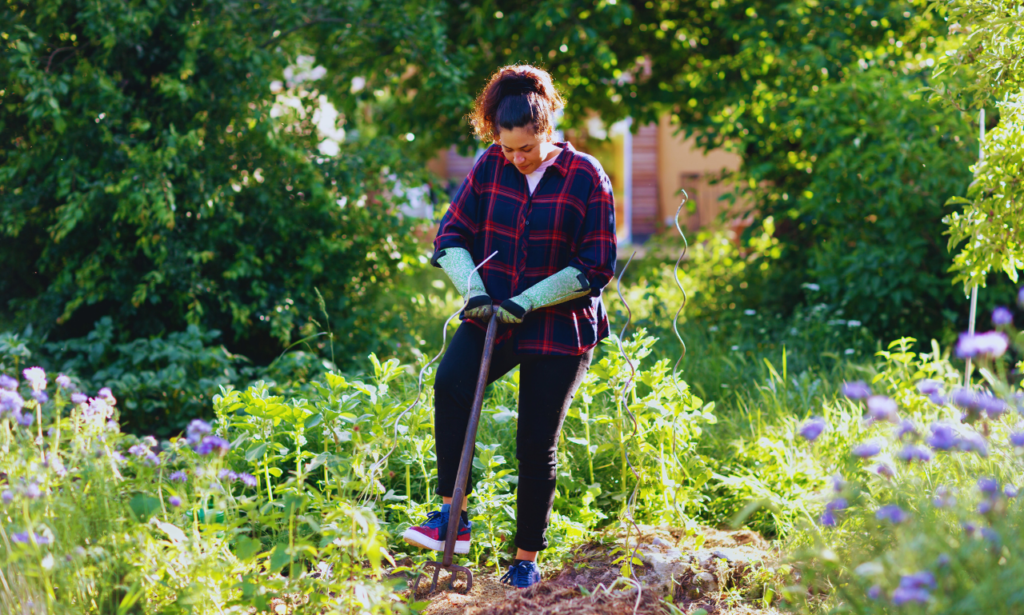
- Understanding Sunlight Needs: Different plants have varying sunlight requirements, so it’s essential to position your containers accordingly. Most flowering plants and vegetables need at least 6-8 hours of direct sunlight daily while shade-loving plants can thrive with less. Monitor sunlight moving across your space and arrange your containers for optimal exposure.
- Watering Wisely: Due to their limited soil volume, container plants often require more frequent watering than garden beds. Check the moisture level regularly by sticking your finger about an inch into the soil; if it feels dry, it’s time to water. Aim for deep watering, allowing excess to drain out of the bottom, ensuring that roots are well-hydrated without becoming waterlogged.
- Fertilizing for Growth: As plants grow and produce blooms or fruits, they deplete the nutrients in the potting mix. To provide essential nutrients, use a balanced, slow-release fertilizer or organic options like compost tea. Apply fertilizer according to your plant’s specific needs, especially during the active growth phase of early summer.
- Managing Pests in Containers: Container gardening can attract pests like traditional gardening. Regularly inspect your plants for signs of aphids, spider mites, or whiteflies. Consider using organic pest control methods like neem oil or insecticidal soap to keep your plants healthy without harsh chemicals.
- Designing Your Container Garden: One of the joys of container gardening is the ability to create visually appealing arrangements. Mix plants with different heights, colors, and textures for an eye-catching display. Use thriller, filler, and spiller techniques: taller plants (thrillers) in the center, medium plants (fillers) around them, and trailing plants (spillers) cascading over the edges.
- Consider Companion Planting: When selecting plants for your containers, consider companion planting principles. For instance, planting basil alongside tomatoes maximizes space and enhances growth and flavor while naturally repelling pests.
- Seasonal Care Adjustments: As temperatures rise in early summer, be prepared to adjust your care routine. This might mean more frequent watering, providing shade for sensitive plants during extreme heat, or repotting overcrowded containers. Keep an eye on how your plants respond to changing weather conditions.
Early Summer Lawn Care Tips

As the days grow longer and temperatures rise, early summer is crucial for lawn care. Proper maintenance during this period sets the stage for a lush, vibrant lawn that can withstand the season’s heat. Here are some essential tips to keep your lawn healthy and thriving during early summer:
Mowing Smartly
- Mow at the Right Height: Adjust your mower blade to a higher setting. Cutting grass too short can stress it during hot weather. For most grass types, keep it between 2.5 to 4 inches tall. Taller grass helps shade the roots and retain moisture.
- Mow Regularly: Regular mowing encourages a denser turf, which can help prevent weeds from establishing. Aim to mow every 1 to 2 weeks, depending on growth rate.
Watering Wisely
- Deep Watering: Water your lawn deeply rather than frequently. This encourages deep-root growth. Aim for about 1 to 1.5 inches of water per week through rainfall or irrigation.
- Early Morning Watering: Early morning is the best time to water your lawn. This reduces evaporation and allows grass to dry before evening, helping prevent diseases.
Fertilization
- Feed Your Lawn: Apply a slow-release fertilizer in early summer to promote healthy growth. Look for a fertilizer with a balanced N-P-K ratio suited to your grass type. Avoid over-fertilizing, leading to excessive growth and increased vulnerability to pests and diseases.
- Soil Testing: Conduct a soil test to determine nutrient deficiencies and pH levels. This can guide your fertilization choices, ensuring you provide the proper nutrients at the right time.
Weed Control
- Prevent Weeds: Early summer is prime time for weeds. Apply a pre-emergent herbicide to prevent weeds from germinating. Be cautious, as timing is crucial; apply it before weed seeds begin to sprout.
- Manual Removal: For existing weeds, hand-pull or use a weeding tool to remove them before they set seeds. This is most effective when the soil is moist.
Aeration and Dethatching
- Aerate Your Lawn: Consider aerating in early summer if your lawn has heavy foot traffic or compacted soil. Aeration allows air, water, and nutrients to penetrate the soil more effectively, promoting healthier grass.
- Dethatching if Necessary: If your lawn has a thatch layer over 1/2 inch thick, dethatching can help. Thatch can suffocate grass roots and create a breeding ground for pests. Use a dethatching rake or machine to remove excess thatch.
Pest Management
- Monitor for Pests: Watch for signs of lawn pests like grubs, chinch bugs, and armyworms. Early detection is key. Look for irregular patches, browning grass, or insect activity.
- Natural Control Methods: If pests are detected, consider using natural pest control methods, such as beneficial nematodes for grubs or insecticidal soap for surface pests. Chemical treatments should be a last resort.
Grass Seed and Overseeding
- Overseed Thin Areas: If your lawn has bare or thin patches, overseeding in early summer can help thicken it up. Choose a grass seed that is appropriate for your climate and lawn conditions.
- Water New Seeds: Keep the soil consistently moist until the new grass is established. Light, frequent watering is better than heavy watering.
Edging and Trimming
- Edge Your Lawn: Use an edger or string trimmer to define the edges of your lawn. This creates a clean look and helps prevent grass from creeping into flower beds and walkways.
- Trim Wisely: Regularly trim grass around trees, garden beds, and other obstacles to maintain a tidy appearance.
Mulching
- Use Grass Clippings: After mowing, leave grass clippings on the lawn. They act as a natural fertilizer and help retain soil moisture, reducing the need for additional watering.
- Mulch Flower Beds: Apply mulch around trees and flower beds to suppress weeds and maintain soil moisture. Organic mulches, such as wood chips or shredded leaves, also improve soil health as they break down.
Plan for Heat Stress
- Be Proactive: As temperatures rise, be mindful of potential heat stress. If a heat wave is forecasted, consider delaying mowing and watering in the evening to minimize stress on the grass.
- Adjust Watering Schedule: During extreme heat, adjust your watering schedule as needed to ensure your lawn remains hydrated without over-watering.
Conclusion
Early summer is a pivotal period for lawn care, laying the foundation for a lush, green landscape that endures through the hotter months. By implementing the strategies outlined—such as intelligent mowing practices, deep watering techniques, adequate fertilization, and proactive pest management—you can ensure your lawn looks excellent and thrives. This season is about balance; understanding when and how to care for your lawn will significantly affect its health and appearance. Remember, a little effort goes a long way, and by following these early summer tips, you’ll create an outdoor space that invites enjoyment, relaxation, and pride. Embrace the season and watch your lawn flourish!
FAQs
1. When should I start mowing my lawn in early summer?
It’s best to start mowing your lawn when the grass reaches about 3 to 4 inches in height. During early summer, mow regularly, typically every 1 to 2 weeks, to keep it healthy and prevent weeds.
2. How often should I water my lawn in early summer?
Aim to provide about 1 to 1.5 inches of water per week from rainfall or irrigation. Water deeply and infrequently to encourage profound root growth, ideally early in the morning, to minimize evaporation.
3. What type of fertilizer should I use in early summer?
Use a slow-release fertilizer that suits your grass type. A balanced N-P-K ratio will support healthy growth. Conduct a soil test to determine specific nutrient needs.
4. How can I prevent weeds from taking over my lawn?
Apply a pre-emergent herbicide in early summer to stop weeds before they germinate. Regularly mowing and hand-pulling existing weeds can help keep them in check.
5. What should I do if I notice pests on my lawn?
Monitor for signs of lawn pests like grubs or chinch bugs. Early detection is critical; if pests are present, consider using natural pest control methods, such as beneficial nematodes, before using chemical treatments.

